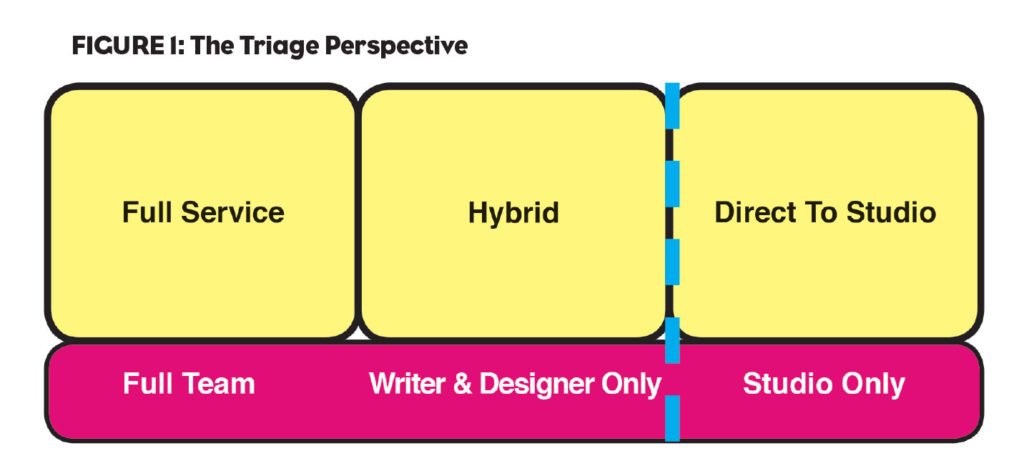Collaboration to achieve competitive advantage is rapidly becoming a strategic imperative for healthcare companies as they pursue and create partnering opportunities to develop and commercialize new brands. Collaboration is also becoming imperative in the agency world as more and more clients are looking for solutions that unify the capabilities of more than one marketing discipline, requiring agency partners to work in harmony.
While many agencies are starting to reap the benefits of such collaborations, some partnerships are still failing to deliver the promised mutual value. The reality is that the most successful partnerships don’t exist because the client said to do it, but because in the hearts and minds of the partners, there is a willingness and openness to work in this new way.
In a boundaryless world, where one moment you are competing with a sister company and the next you are collaborating, partnerships require a fundamentally different attitude and approach. From work that Omnicom has done in healthcare collaborations (with companies in and outside of our holding company), we’ve uncovered some fundamental “how to’s” for mutually profitable partnerships.
1. How to Avoid a Family Feud
Imagine planning a vacation where every family member has a vote. That’s what happens when agencies partner. Everybody has different objectives, wants to go somewhere different, and do different things. The challenge is to make sure the final destination excites and motivates everyone without becoming the lowest common denominator.
The platform for a successful partnership starts with a shared vision that drives all decision-making and activity. The vision serves as the unifying factor in bringing disparate companies together with different goals and needs. It clarifies the common interests and sets the stage for the development of the model of working together. In adopting a way of working, the vision should link with the clients’ vision and culture to provide a common philosophy that drives a successful partnership.
The result? The agency partners can maintain total focus on strategic and creative excellence even as organizational and economic efficiencies are established.
Defining strategic direction provides the road map for success and drives the focus and actions of the team. In Omnicom’s most effective collaborative teams, developing the vision is undertaken by all agency partners together to ensure that all parts of the team are working in concert and reinforcing the successful activities of the other. It creates a framework in which resources can be allocated and choices can be made when selecting among multiple opportunities.
2. How to Actually Get Things Done
The old saying is even truer today: “What gets measured gets done.” That’s why successful collaborative teams define success through objective measures. They have clearly defined performance targets that are routinely monitored, and action is quickly taken to address any negative variance. The use of meaningful metrics informs all decision-making and guides operations.
It’s also crucial to have an effective governance structure that facilitates stakeholder engagement in the team’s success. Successful governance provides the framework for joint decision-making and can facilitate the collaboration necessary to make it work. It also must provide leadership to guide the organization through difficult decisions and choices that may not be universally popular. Governance provides a structure for individuals to make their voices heard and facilitates buy-in on team decisions, and it requires stakeholders to put aside their individual biases and represent the interests of the team overall.
A compensation model that’s aligned with the team’s vision and strategic direction as well as with the clients’ financial realities, is also key to getting things done. The compensation model should reinforce and support the drivers for success. Be careful to recognize that productivity is not the only driver, and that your compensation model should also reward quality and value.
3. How to Avoid the “Nobody Told Me” Syndrome
In collaborative teams, “over-communicating” is not a bad thing and communication must happen consistently and often between and among the team and leadership. While formal communication methods such as meetings and emails are important, informal communication is even more important.
Leaders of collaborative teams must be visible and approachable and in the trenches working alongside the team. Decisions and actions should be explained and transparent. Opportunities for team members to get together in social or informal settings should be created to assure familiarity and to support group culture development.
4. How to Ensure that People Think, Rather than Just Do
We’ve established that a successful collaborative team has to have the right leadership, both strategic and operational. And, these leaders have to understand collaboration and teamwork, be able to create a vision, communicate effectively, and make the tough decisions when necessary. These kinds of leaders are not necessarily born, they have to be developed. Invest in the education and training of current and future leaders and recognize the need for both visionaries and operational leaders.
5. How to Make Efficiency and Excellence a Habit, Not a Goal
Effective collaborative teams are actively engaged in the “business” side of what they do. They employ experts who understand agency economics and operations, with a focus on operational efficiency and effectiveness. They recognize that team members play a key role in driving both revenue and expenses. Consequently, no team member can be removed from the business of the team. A commitment to excellence drives everything that the collaborative team does, from its hiring decisions to its model design. It continually challenges itself to do better and engages in continuous quality improvement. It is rigorously disciplined about all of its activities. Accountability exists at every level of the model.
Each collaborative team creates a culture that drives success based on the vision, governance, and infrastructure to drive achievement. They select the right leaders and hire the right people. They understand the business and are disciplined about measuring results. And a commitment to excellence—in both execution and results—drives everything we do.
Case Study: Bringing it All Together
This case study demonstrates how Omnicom has activated these success drivers in consolidating healthcare marketing in large, global healthcare companies.
The Challenge: Company X, a division of a large healthcare company, had a multitude of agency partners around the world and an inefficient cost structure to match. Their aim was to improve marketing effectiveness locally and globally, and drive savings by consolidating the sourcing of all marketing services for these companies. The hope: “…the majority of all creative and strategic services will be provided by one holding/parent company partner, rather than dozens of individual agencies.”
Besides better integration and more cost-effective marketing, Company X hoped to cut their time spent managing dozens of vendors and hundreds of projects. “Consolidation will allow our global marketing staff to focus on the brand and the marketplace and on maximizing how to deliver the best marketing strategies and programs to impact our business.”
Making this even more interesting was the client’s stated need to actively support diverse businesses. They charged Omnicom with ensuring that 5% of total billings would be attributed to qualified small and diverse-owned businesses. The issue was compounded in that the client had only a very small list of pre-approved qualified suppliers. To spend this type of volume meant we had to dramatically increase that number of suppliers. We immediately vetted a wide variety of independent diverse agencies across several disciplines, all of whom would be partners to the agencies serving Company X. As a result, Omnicom has consistently surpassed our 5% total billings target.
Company X noticed a number of issues affecting the effectiveness of this division’s marketing and challenged us with the following questions: Could we get rid of the constant ambiguity by providing clarity of function, reporting lines, and clarity of process? Could we eliminate the repetition and duplication of everything from strategy to creative development to production assets? Could we accelerate learning to squeeze time out of the system and better compete? And could we do it all while ensuring a higher level of creative excellence, which tended to be spotty in the past?
The Solution: By bringing different agencies together, we looked at the client’s requirements with new eyes and realized that by rethinking what a Scope of Work really meant, we could drive significant efficiencies.
We looked at SOWs from a Triage perspective and developed the construct shown in Figure 1.
 The Result: With this mindset we were able to cut the client’s costs pretty dramatically, particularly with the Direct To Studio designation. This was a lower-priced, faster alternative for revising existing tactics, or for creating new tactics based on existing artwork that had already been executed and produced. This increased the speed to market, lowered production costs by 30% to 40%, reduced the number of touches, and saved the client hours of management time.
The Result: With this mindset we were able to cut the client’s costs pretty dramatically, particularly with the Direct To Studio designation. This was a lower-priced, faster alternative for revising existing tactics, or for creating new tactics based on existing artwork that had already been executed and produced. This increased the speed to market, lowered production costs by 30% to 40%, reduced the number of touches, and saved the client hours of management time.
This construct allowed Company X to get the best talent from each agency that works on their business. The compensation structure helped achieve this. The client no longer paid its agency partners for each hour worked. Instead, the agency is paid a set amount of money for an agreed Scope of Work. Fewer people work on the business, and the agency teams are encouraged to use better people, produce better work faster, and therefore cost the client significantly less.
As we said earlier in our five key drivers, getting the family on the same page is crucial. One of the keys to a successful consolidation is for all parties to know when they’re getting involved, to what extent, and to what end.






